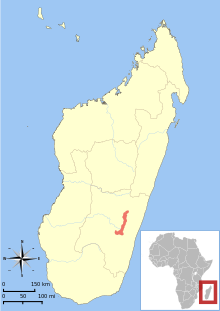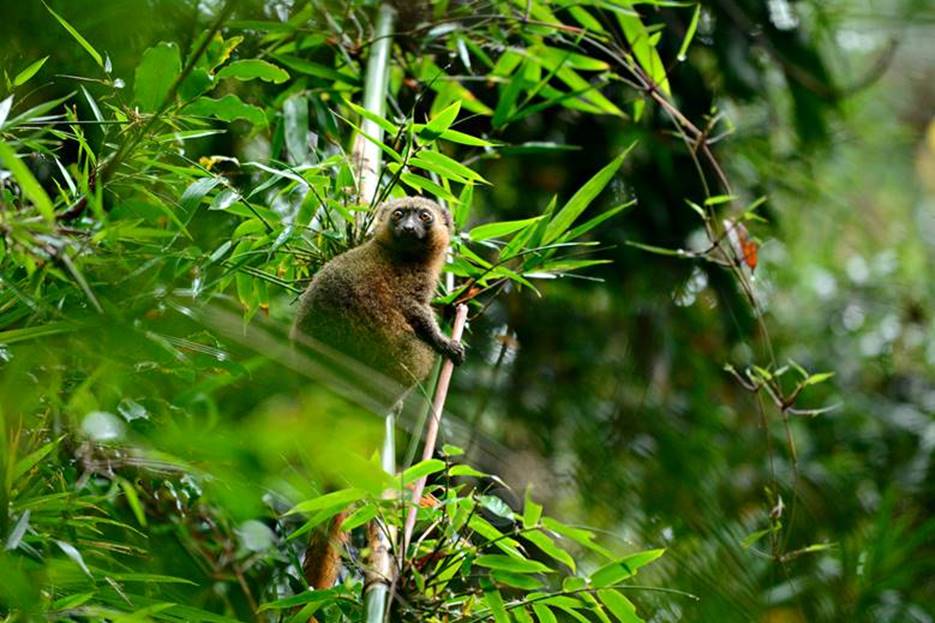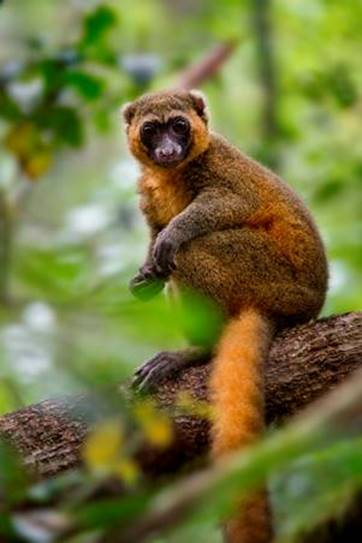There is nothing more exciting than finding a new thing nobody knows. You won’t believe it, but everything hasn’t already been discovered.” Patricia Wright.
his is a medium sized lemur native to a small area on the island of Madagascar. It is diurnal, most active during the day with discrete rest periods between mid-morning and early afternoon. They spend their day resting (50%), feeding (41%), and travelling (8%).
The golden bamboo lemur is about the size of an average cat – 3.5 lbs and 11-18 inches long with a long tail (9.5 – 16 inches). It is found at elevations between 2,000 and 4,600 ft. in and around Ranomafana National Park, Andrigitra National Park and possibly the forested corridor that connects them. Their home range is pretty small, only about 0.1 mi2. They are thought to live up to 23 years.
The species was discovered in 1986 and is the reason that Ranomafana National Park was established. There are only about 1,000 or so of these animals in the wild, which are threatened by habitat loss from slash and burn agriculture that is prevalent throughout Madagascar. This species is listed as Critically Endangered by the International Union for Conservation of Nature (IUCN).
Hapalemur, Hapale – Greek, meaning gentle – thus gentle lemur, and aureus – golden.

Patricia Wright, an American primatologist, discovered the golden bamboo lemur while hunting for the greater bamboo lemur. The story goes that after some time in the jungle, she and her team headed for a small hotel, seeking some down time and a well-deserved shower. She noticed that the forest around the hotel was quite impressive and despite her fear of heights, took a rickety footbridge over a river into the forest where she got her first glimpse of this undescribed species. It took another 6 months to dart one with a sedative and make the morphological and genetic comparisons to declare it a new species.
The golden bamboo lemur has pale orange fur on the back with grey to brown guard hair and a yellowish belly. It has a short snout and a black face with golden eyebrows, throat, and cheek. It has short hairy ears and males and females look similar. These lemurs live in family groups of between two to six individuals. Females give birth in November and December.
Interestingly, the bamboo that this lemur feeds upon contains very high concentrations of cyanide. The amount of cyanide they consume daily is between 12- 48 times the lethal dose for a similar sized mammal. The toxicity of cyanide to vertebrates is primarily due to inhibition of mitochondrial respiration. It also blocks oxygen from binding with hemoglobin and interferes with a number of enzymes. Plants have evolved this toxicity as a defense against animals eating them and in turn animals evolve ways around these defenses.
In theory, there are some evolutionary risks to becoming as specialized as the golden bamboo lemur, which primarialy forages on bamboo. In the continued arms race between bamboo cyanide toxicity and the lemur’s ability to thwart this, there may be an upper threshold of cyanide concentration to which the lemur cannot physiologically adapt – thus leaving them at a dead end and likely not able to adapt to other food sources as quickly as needed. In theory.
The diet of these lemurs is about 88% bamboo, the rest made up of leaves, fruits, flowers, and fungus. Predators of this lemur include the Malagasy tree boa, Henst’s goshawk, and the Madagascar harrier-hawk. A recent study indicated that bamboo lemurs have 13,816 different “operational taxonomic units” – or types of microbes – in their guts, leading some to speculate on their role in assisting the lemurs deal with the toxicity of their favorite food. That is the highest number of types of gut microbes in any animal examined and about 14 times that of humans.
It was our first morning in Ranomafana National Park and it felt like a rain forest, steamy and green. As with all Madagascar parks you have to go in with a local guide and we were wandering along the paths when our guide, Florence, made a bee line into the forest beckoning us to follow. I could see a lemur, some type of lemur, wandering around the bamboo stand, swaying at the top of the stalks. It took 20 minutes or so before we confirmed, yes, it was a golden bamboo lemur – and then another 20 minutes and about 50 photographs to get a decent one.
“Oh, you are lucky to see one. It’s a good morning” said Florence. Indeed.

